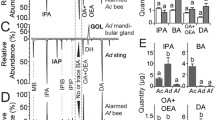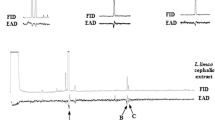Abstract
The nest of the stingless bee,Trigona (Tetragonisca) angustula, is guarded by bees positioned in the nest entrance and others hovering in front of it. Hovering guard bees track returning foragers sideways along the last 10 cm in front of the nest, but intercept and incapacitate nest intruders by clinging with mandibles to wings and legs. When attacked by the cleptobiotic stingless beeLestrimelitta limao, the colony strengthens its aerial defense with hundreds of additional hoverers. To test our hypothesis that this reaction is due to interspecific chemical communication based on kairomone effects, we presented synthetic cephalic volatiles of both species at the nest entrance and counted the number of bees leaving the nest and taking up hovering positions. We conclude that guard bees recognizeL. limao by the major terpenoids of their volatile cephalic secretions, geranial, neral (=citral) and 6-methyl-5-hepten-2-one; other components may fine-tune this recognition. The effect of chemical stimuli is not significantly enhanced by combination with a dummy ofL. limao. Guard bees, we hypothesize, respond to this kairomone by secreting a species specific alarm pheromone; a major component of this pheromone, benzaldehyde, recruits additional bees to defend the nest.
Similar content being viewed by others
References
Blum, M.S. 1966. Chemical releasers of social behavior. VIII. Citral in the mandibular gland secretion ofLestrimelitta limao (Hymenoptera: Apoidea: Melittidae).Ann. Entomol. Soc. 59:962–964.
Blum, M.S., Crewe, R.M., Kerr, W.E., Keith, L.H., Garrison, A.W., andWalker, M.M. 1970. Citral in stingless bees: Isolation and function in trail laying and robbing.J. Insect Physiol. 16:1637–1648.
Camargo, J.M.F., Moure, J.S., andRoubik, D.W. 1988.Melipona yucatanica, new species (Hymenoptera: Apidae: Meliponinae); Stingless bee dispersal across the Caribbean arc and post-Eocene vicariance.Pan-Pac. Entomol. 64:147–157.
Johnson, L.K. 1987. The pyrrhic victory of nest robbing bees: Did they use the wrong pheromone?Biotropica 19:188–189.
Michener, C.D. 1974. The Social Behavior of the Bees. Harvard University Press, Cambridge, Massachusetts.
Moure, S.J., Nogueira-Neto, P., andKerr, W.E. 1956. Evolutionary problems among the Meliponinae.Proc. Int. Congr. Entomol. 2:481–493.
Nogueira-Neto, P. 1970. Behavior problems related to the pillages made by some parasitic stingless bees (Meliponinae, Apidae). Freeman, Reading. Essays in Memory of T.C. Schneirla, Jr. 416–434.
Sakagami, S.F.,Roubik, D.W., andZucchi, R. 1990. Foraging behavior of the robber bee,Lestrimelitta limao (Hymenoptera, Apidae).Ecol. Monogr. In press.
Schröder, W. 1985. Vergleichende Untersuchungen flüchtiger Inhaltsstoffe von solitären und sozialen Bienen. Dissertation. Fachbereich Chemie, University of Hamburg.
Schwarz, H.R. 1948. Stingless bees (Meliponidae) of the Western Hemisphere.Bull. Am. Mus. Nat. Hist. 900:1–546.
Weaver, N., Weaver, B.C., andClarke, E.T. 1975. Reactions of five species of stingless bees to some volatile chemicals and to other species of bees.J. Insect Physiol. 21:479–494.
Wille, A. 1961. Las abejas jicotes de Costa Rica.Rev. Univ. Costa Rica 22:1–30.
Wille, A. andMichener, C. D. 1973. The nest architecture of stingless bees with special reference to those of Costa Rica.Rev. Biol. Tropical 21:1–278.
Wittmann, D. 1985. Aerial defense of the nest by workers of the stingless beeTrigona (Tetragonisca) angustula (Latreille) (Hymenoptera: Apidae).Behav. Ecol. Sociobiol. 16:111–114.
Zeil, J., andWittmann, D. 1989. Visually controlled station-keeping by hovering guard bees ofTrigona (Tetragonisca) angustula (Apidae, Meliponinae).J. Comp. Physiol. A165:1–278.
Author information
Authors and Affiliations
Rights and permissions
About this article
Cite this article
Wittmann, D., Radtke, R., Zeil, J. et al. Robber bees (Lestrimelitta limao) and their host chemical and visual cues in nest defense byTrigona (Tetragonisca) angustula (Apidae: Meliponinae). J Chem Ecol 16, 631–641 (1990). https://doi.org/10.1007/BF01021793
Received:
Accepted:
Issue Date:
DOI: https://doi.org/10.1007/BF01021793




